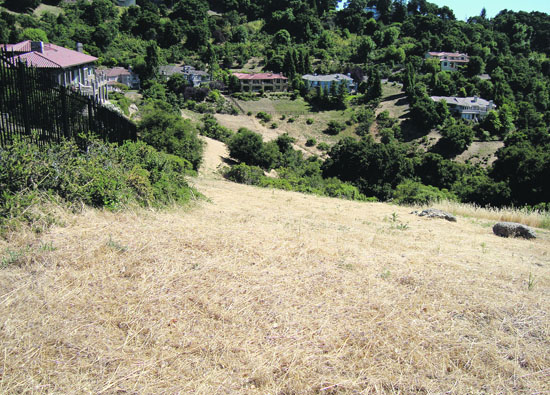 | | | Ellen Dale's neighborhood from behind her fence; all the weeds have been cut down, right up to the common areas. Photo Ellen Dale
| | | | | | It's the beauty of the open space that draws many to Moraga, Orinda and Canyon. However, with this beauty comes responsibility. The Oak, Buckeyes, and Pine trees juxtaposed against the golden brown hillsides may be visually stunning, but they can pose a wildfire threat, especially to homes that back directly up to that open space.
 According to Moraga Orinda Fire District (MOFD) Fire Marshall Mike Mentink, all residents in MOFD's area are required to keep their homes as fire-safe as possible. However, because of the proximity to open space or their size, there are a number of properties that fall into the category of Very High Fire Hazard Severity Zone (VHFHSZ) and must maintain their properties specifically to lower the fire risk.
According to Moraga Orinda Fire District (MOFD) Fire Marshall Mike Mentink, all residents in MOFD's area are required to keep their homes as fire-safe as possible. However, because of the proximity to open space or their size, there are a number of properties that fall into the category of Very High Fire Hazard Severity Zone (VHFHSZ) and must maintain their properties specifically to lower the fire risk.
 Mentink said that in 1997, MOFD developed a mapping program identifying properties in the District's high fire zones. Last year, about 2,800 homes in the MOFD area were in that category. Recently, Cal Fire completed a statewide audit, identifying geographic areas that fell into the VHFHSZ. Mentink said that when the state's map was overlaid onto MOFD's existing map, along with the original 2,800 homes, an area of approximately 1,300 homes in the northwest part of Orinda were considered in the VHFHSZ. MOFD adopted the map and these homes are now required to comply with abatement standards.
Mentink said that in 1997, MOFD developed a mapping program identifying properties in the District's high fire zones. Last year, about 2,800 homes in the MOFD area were in that category. Recently, Cal Fire completed a statewide audit, identifying geographic areas that fell into the VHFHSZ. Mentink said that when the state's map was overlaid onto MOFD's existing map, along with the original 2,800 homes, an area of approximately 1,300 homes in the northwest part of Orinda were considered in the VHFHSZ. MOFD adopted the map and these homes are now required to comply with abatement standards.
 The residents in the new area received the same notices as everyone else, said Mentink, however they also received a note saying the District was available for consultation to help them understand exactly what they had to do.
The residents in the new area received the same notices as everyone else, said Mentink, however they also received a note saying the District was available for consultation to help them understand exactly what they had to do.
 Orinda resident Ellen Dale lives in the newly designated VHFHSZ area. "At first it kind of scared me," she said. "But then I realized that nothing had really changed. Every year we have our gardener take a weed whacker and clear as much of our property as possible."
Orinda resident Ellen Dale lives in the newly designated VHFHSZ area. "At first it kind of scared me," she said. "But then I realized that nothing had really changed. Every year we have our gardener take a weed whacker and clear as much of our property as possible."
 Dale said most of the properties in her neighborhood are about 2 acres in size and while some were aware of the need to keep a large defensible space, some were not. "These letters have definitely motivated some of the neighbors who had been doing just the minimum to really clear far down on their properties," she said.
Dale said most of the properties in her neighborhood are about 2 acres in size and while some were aware of the need to keep a large defensible space, some were not. "These letters have definitely motivated some of the neighbors who had been doing just the minimum to really clear far down on their properties," she said.
 Dale noted that while she is pleased the letters have motivated people, there is still much concern. She said she sees trees overhanging houses, overgrown vegetation, and steep hills overgrown with grasses which all need to be top of mind when it comes to fire prevention. She hopes the abatement letters will have an effect. "We need to pay attention. We need to remember we are at risk," she said. "A brush fire can quickly become a conflagration."
Dale noted that while she is pleased the letters have motivated people, there is still much concern. She said she sees trees overhanging houses, overgrown vegetation, and steep hills overgrown with grasses which all need to be top of mind when it comes to fire prevention. She hopes the abatement letters will have an effect. "We need to pay attention. We need to remember we are at risk," she said. "A brush fire can quickly become a conflagration."
 When Randy Bradley was brought on as Fire Chief for MOFD, he was charged by the Board of Directors to bring his experience with the National Fire Protection Association and International Association of Fire Chiefs to best serve the District, especially in terms of wildland/urban interface issues.
When Randy Bradley was brought on as Fire Chief for MOFD, he was charged by the Board of Directors to bring his experience with the National Fire Protection Association and International Association of Fire Chiefs to best serve the District, especially in terms of wildland/urban interface issues.
 "While the District is required by statute to enforce regulations that address exterior hazards in VHFHSZs, we are more interested in working with the homeowners to identify simple steps they can take to increase the survivability of their homes during wildfires," said Bradley. "We plan to use national programs that are based on fairly new scientific studies that provide a good understanding of how homes actually burn and what can be done to prevent home ignition.
"While the District is required by statute to enforce regulations that address exterior hazards in VHFHSZs, we are more interested in working with the homeowners to identify simple steps they can take to increase the survivability of their homes during wildfires," said Bradley. "We plan to use national programs that are based on fairly new scientific studies that provide a good understanding of how homes actually burn and what can be done to prevent home ignition.
 One national program he hopes to initiate locally is the "Home Ignition Zone Evaluation," where a group of trained volunteers work with homeowners to identify things they can do to prevent their home from burning. "This is above and beyond the abatement program," said Bradley. "We hope to do a trial program beginning with a homeowners association in Orinda."
One national program he hopes to initiate locally is the "Home Ignition Zone Evaluation," where a group of trained volunteers work with homeowners to identify things they can do to prevent their home from burning. "This is above and beyond the abatement program," said Bradley. "We hope to do a trial program beginning with a homeowners association in Orinda."
 Dale added that her homeowners association already takes an active role in preventative measures, such as keeping the nearby walking trails trimmed to a safe level, but the individual homeowner must act, too. "People in Orinda need to understand that something like (the Oakland Hills fire) could happen here," she said. "We are similar in terms of vegetation and lots of open space."
Dale added that her homeowners association already takes an active role in preventative measures, such as keeping the nearby walking trails trimmed to a safe level, but the individual homeowner must act, too. "People in Orinda need to understand that something like (the Oakland Hills fire) could happen here," she said. "We are similar in terms of vegetation and lots of open space."

|

